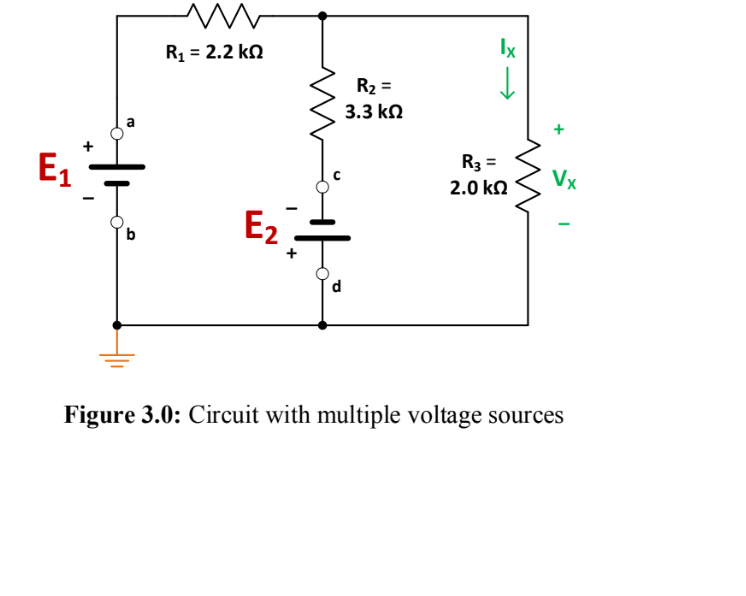2 + E1 - b R₁ = 2.2 k E2 + d lx R₂ = ↓ 3.3 ΚΩ R3 = 2.0 ΚΩ Vx Figure 3.0: Circuit with multiple voltage sources
2 + E1 - b R₁ = 2.2 k E2 + d lx R₂ = ↓ 3.3 ΚΩ R3 = 2.0 ΚΩ Vx Figure 3.0: Circuit with multiple voltage sources
Delmar's Standard Textbook Of Electricity
7th Edition
ISBN:9781337900348
Author:Stephen L. Herman
Publisher:Stephen L. Herman
Chapter18: Resistive-inductive Parallel Circuits
Section: Chapter Questions
Problem 16PP: An R-L parallel circuit has an applied voltage of 208 volts and a total current of 2 amperes. The...
Related questions
Question
(i) For the circuit shown in Figures 3.0, consider the input D.C. source voltages, E1 = 5V and E2 = 2V (note the polarities of each source!). Determine the values of voltage, VX and current, IX using either the nodal-voltage or the mesh-current analysis technique. Show your analysis below, and record your results in Table 4.0.
(ii) For the same circuit shown in Figures 3.0 with the input D.C. source voltages, E1 = 5V and E2 = 2V, apply the Superposition Principle technique as follows:-
- Remove input source, E2 and replace it with a short-circuit by connecting a wire between “c” and “d”. Determine the resultant voltage, VX1 across R3 and current, IX1 through R3. Show your analysis below, and record the results in Table 4.0.
- Connect input source, E2 in its original place between “c” and “d”. Be mindful of the polarity connections. Then remove input source, E1 and replace it with a short-circuit by connecting a wire between “a” and “b”. Determine the resultant voltage, VX2 across R3 and current, IX2 through R3. Show your analysis below, and record the results in Table 4.0.

Transcribed Image Text:2
+
E1
-
b
R₁ = 2.2 k
E2
+
d
lx
R₂ =
↓
3.3 ΚΩ
R3 =
2.0 ΚΩ
Vx
Figure 3.0: Circuit with multiple voltage sources
Expert Solution
This question has been solved!
Explore an expertly crafted, step-by-step solution for a thorough understanding of key concepts.
Step by step
Solved in 1 steps with 4 images

Recommended textbooks for you

Delmar's Standard Textbook Of Electricity
Electrical Engineering
ISBN:
9781337900348
Author:
Stephen L. Herman
Publisher:
Cengage Learning

Delmar's Standard Textbook Of Electricity
Electrical Engineering
ISBN:
9781337900348
Author:
Stephen L. Herman
Publisher:
Cengage Learning